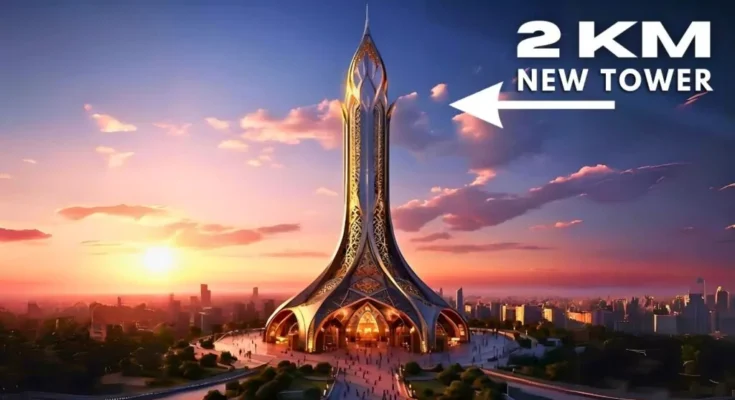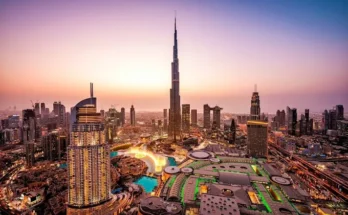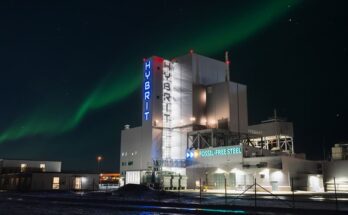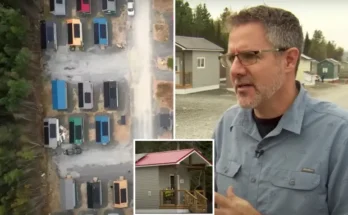High above the vast desert expanse of Riyadh, a groundbreaking project is poised to redefine the limits of human ambition and architectural ingenuity—the Rise Tower. When completed, it will not only claim the title of the tallest building in the world but also symbolize Saudi Arabia’s aspirations for global leadership in innovation and development.
The Concept of the Rise Tower
Rise Tower is a proposed 2-kilometer-tall skyscraper that aims to shatter existing records and set new benchmarks for urban architecture. Conceived by Saudi Arabia’s Public Investment Fund (PIF) in December 2022, it is the centerpiece of the North Pole project, a visionary mixed-use development that aspires to be the “city of the future.”

Situated on an 18-square-kilometer area in northern Riyadh, near King Khalid International Airport, the project reflects Saudi Arabia’s ambition to diversify its economy and invest in groundbreaking infrastructure. With an estimated budget of $5 billion, the tower will surpass Dubai’s Burj Khalifa by an astonishing 1,180 meters, reaching a total height of 2 kilometers.
The North Pole Project

The Rise Tower is the crown jewel of the North Pole project, which spans an impressive 306 square kilometers. This futuristic city will incorporate residential neighborhoods, commercial spaces, cultural centers, and recreational facilities, all seamlessly integrated into a smart and sustainable urban environment.
The development embodies Saudi Vision 2030, a strategic initiative to reduce the kingdom’s dependency on oil and promote tourism, technology, and innovation. The North Pole project is expected to draw international attention and position Riyadh as a hub for forward-thinking architectural and economic endeavors.
Engineering and Architectural Innovations

Constructing a skyscraper of this magnitude presents unparalleled engineering challenges. Rise Tower will require cutting-edge materials and design solutions to achieve its monumental height while ensuring structural integrity and safety.
Foundation and Support: To anchor a 2-kilometer-tall structure, the tower will feature an exceptionally deep foundation reinforced with ultra-high-strength concrete. Engineers will employ advanced techniques to ensure stability in Riyadh’s desert environment.
Aerodynamic Design: The building’s shape will be carefully engineered to reduce wind resistance and minimize the sway experienced at extreme heights. The innovative design will enhance both safety and occupant comfort.

Energy Efficiency: Sustainability is a core principle of the project. Rise Tower will incorporate renewable energy systems, such as solar panels and wind turbines, to minimize its environmental footprint. Advanced water recycling systems and energy-efficient technologies will further enhance its eco-friendliness.
Features of the Rise Tower

The Rise Tower is designed to be a self-contained vertical city, offering a wide array of amenities and experiences. Key features include:
Observation Decks: Positioned at record-breaking heights, these decks will provide breathtaking views of Riyadh and beyond, attracting tourists and residents alike.
Luxury Accommodations: The tower will house world-class hotels, offering unparalleled luxury and panoramic vistas.
Residential Units: High-end apartments will provide a unique living experience, blending opulence with futuristic smart home technologies.
Commercial Spaces: The tower will host premium office spaces equipped with state-of-the-art facilities, catering to global businesses.
Cultural and Recreational Areas: Art galleries, theaters, and green spaces will foster a vibrant community atmosphere within the skyscraper.
Timeline and Challenges
Since its announcement in 2022 and the unveiling of its designs in August 2023, Rise Tower has captured global attention. However, such an ambitious project comes with significant challenges.
Economic Considerations: The $5 billion price tag reflects the complexity and scale of the project. Securing consistent funding and managing costs will be critical to its success.
Technological Barriers: Building a structure of this magnitude requires innovations in construction techniques, materials, and technologies that push current boundaries.
Environmental Factors: The harsh desert climate poses unique challenges, including temperature fluctuations and sandstorms, which engineers must address.
Despite these hurdles, the project is a testament to Saudi Arabia’s resilience and forward-thinking approach. Construction is expected to proceed in phases, with updates eagerly anticipated by the global community.
A Monument to Human Ambition
When completed, Rise Tower will not only stand as the tallest building in the world but also as a beacon of human perseverance and creativity. It will symbolize a new era for Riyadh and Saudi Arabia, showcasing their ability to dream big and achieve the extraordinary.
The Rise Tower is more than a skyscraper; it is a story of ambition and innovation that inspires the world to look upward and imagine the limitless possibilities of the future.



